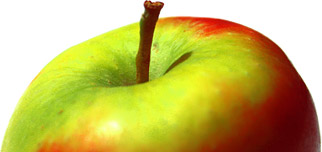Also known as Early Victoria, Emneth Early is a very early-season 'codlin' type apple. It was grown commercially in East Anglia and elsewhere, particularly for jam production.
USDA identification images for Emneth Early
The identification paintings in the USDA Pomological Watercolor Collection span the years 1886 to 1942.
Citation: U.S. Department of Agriculture Pomological Watercolor Collection. Rare and Special Collections, National Agricultural Library, Beltsville, MD 20705.
Parents and other ancestors of this variety
- Keswick Codlin (parent)
Visitor reviews
- 05 Aug 2018 CUMBRIA, United KingdomI have inherited an Emneth Early tree. The tree is about 15 feet in height but needs some pruning as has not been touched for a few years. It has a lot of beautiful apples on it. They are a good large palm size and a pale greenish yellow. Their smell has subtle sweet floral notes with the flesh being tart and quite soft and not so crunchy unless eaten straight from the tree! The apples start to fall in late July early August. They do not keep at all well but make great purée and also are nice to dehydrate as apple rings. Nice apples but not if you want keepers.
- 24 Sep 2017 RUTLAN, United KingdomBack in the 1940s a school friend in Wisbech near Emneth had an Emneth Early apple tree. I took loads home for mum to cook with. Those apples that ripened on the tree turned a pale yellow, and made a good eating apple. Today I live in Rutland. My neighbour has a 68 year old Emneth Early tree, still bearing fruit and in excellent condition. These are the only two trees of type I have seen.
Tree register
United Kingdom
- Adrian Hodge in Dereham, NORFOLK
- Graham Ward in Coldstream, BERWICKSHIRE
- Phil Stevenson in Rugeley, STAFFORDSHIRE
- Sarah Temple in Inverurie, ABERDEENSHIRE
Ireland
- Ute Bohnsack in Kilfenora, CLARE
Harvest records for this variety
2021 season
- 4th week July 2021 - tree owned by Graham in Coldstream, United Kingdom
2018 season
- 1st week September 2018 - tree owned by Sarah in Inverurie, United Kingdom
2011 season
- 2nd week August 2011 - tree owned by Ute in Kilfenora, Ireland
2010 season
- 2nd week August 2010 - tree owned by Ute in Kilfenora, Ireland
Origins
- Species: Malus domestica - Apple
- Parentage: Lord Grosvenor x Keswick Codlin
- Originates from: Emneth, Cambridgeshire, United Kingdom
- Introduced: 1899
- Developed by: William Lynn,
- UK National Fruit Collection accession: 1975-321
Identification
- Awards: RHS AGM (current)
- Country of origin: United Kingdom
- Period of origin: 1850 - 1899
- Flower colour: Pink - light
- Leaf colour: Green
- Popularity: Rarely grown
- Annual cycle: Deciduous
Using
- Picking season: Early
- Keeping (of fruit): 2-3 weeks
- Flavour quality: Good
- Cooking result: Puree
- Vitamin C content: Medium
- Cropping: Heavy
- Food uses: Culinary
- Food uses: Traditional cooker
- Picking period: mid-August
- Wildlife: RHS Plants for Pollinators
Growing
- Gardening skill: Beginner
- Flowering group: 3
- Pollinating others: Average
- Ploidy: Diploid
- Vigour: Average vigour
- Precocity: Precocious
- Bearing regularity: Biennial tendency
- Fruit bearing: Spur-bearer
- Self-fertility: Partially self-fertile
Climate
- Frost resistance of blossom: Some resistance
- Climate suitability: Temperate climates
- Climate suitability: Mild damp climates
- Summer average maximum temperatures: Cool ( 20-24C / 68-75F)
- Cold hardiness (RHS): H6 (to -20C)
- Summer average maximum temperatures: Cold (< 20C / 67F)
Other qualities
- Disease resistance: Good
- Canker: Some resistance
- Scab (Apple and Pear): Some resistance
- Powdery mildew: Some resistance
Where to buy fresh fruit
The following orchards grow Emneth Early:
Australia
Victoria
- Heritage Fruits Society, Fairfield
References
- Apples of England (1948)
Author: Taylor - Fruit Expert
Author: Hessayon
As Early Victoria - Some Antique Apples for Modern Orchards, (2008)
Author: Merwin I.A.

